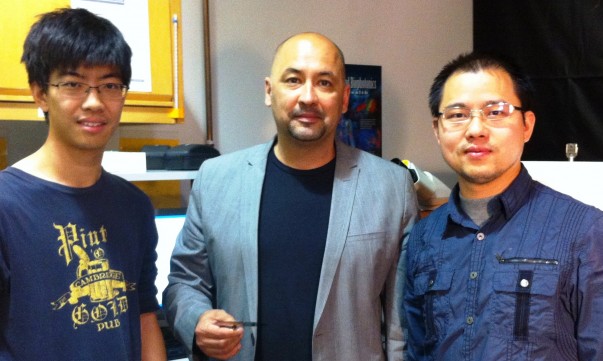ACADEMIA
Not Your Grandma’s Quilt
Researchers develop technique to keep cool high-power semiconductor devices used in wireless applications, traffic lights and electric cars
A group of researchers at the University of California, Riverside Bourns College of Engineeringhave developed a technique to keep cool a semiconductor material used in everything from traffic lights to electric cars.
Gallium Nitride (GaN), a semiconductor material utilized in bright lights since the 1990s, is used in wireless applications due to its high efficiency and high voltage operation. However, the applications and market share of GaN electronics is limited because it is difficult to remove heat from them.
That could change due to a technique developed by the Nano-Device Laboratory research group led by Alexander Balandin, professor of electrical engineering and founding chair of Materials Science and Engineering program.
The research group demonstrated that hot spots in GaN transistors can be lowered by as much 20 degrees Celsius through the introduction of alternative heat-escaping channels implemented with graphene multilayers, which are excellent heat conductors. The temperature reduction translates to an increase in the lifetime of the device by a factor of 10.
“This represents a transformative change in thermal management,” Balandin said.
The new approach to thermal management of power electronics with graphene was outlined in a paper “Graphene quilts for thermal management of high-power GaN transistors” that was published May 8 in Nature Communications.
GaN transistors have been offered commercially since 2006. The problem with them, like all high power operating devices, is significant amount of dissipated heat, which has to be fast and efficiently removed. Various thermal management solutions such as flip-chip bonding or composite substrates have been attempted. However, applications have still been limited because of increases in temperature due to dissipated heat.
The breakthrough in thermal management of GaN power transistors was achieved by Balandin and three of his electrical engineering graduate students: Guanxiong Liu, Zhong Yan, both Ph.D. candidates, and Javed Khan, who earned his Ph.D. and started working at Intel Corporation this year.
Balandin – recipient of IEEE Nanotechnology Pioneer Award for 2011 – has previously discovered that graphene is an excellent heat conductor. Few-layer graphene films preserve their excellent thermal properties even when their thickness is only a few nanometers, which is unlike metal or semiconductor films. The latter makes them excellent candidates for applications as the lateral heat spreaders and interconnects.
The Balandin group researchers designed and built graphene-graphite “quilts” on top of GaN transistors. The graphene-graphite quilts’ function was to remove and spread the heat from the hot spots – the opposite of what you expect from the conventional quilts.
Using micro-Raman spectroscopic thermometry the researchers demonstrated that temperature of the hot spots can be lowered by as much 20 degrees Celsius in transistors operating at the large power levels.
The supercomputer simulations performed by the group suggested that graphene quilts can perform even better in GaN devices on more thermally resistive substrates.
The Balandin group is also known in graphene community for their investigation of low-frequency noise in graphene transistors, development of the first large-area method for quality control of graphene and demonstration of the first selective gas sensor implemented with pristine graphene.
The work on thermal management of GaN transistors with graphene quilts was supported by the Office of Naval Research. Balandin’s research of the thermal properties of graphene was funded by the Semiconductor Research Corporation and the Defense Advanced Research Project Agency.


